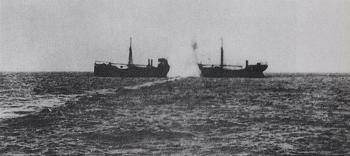

|
Wooden Torpedoes - The German Crisis
A U-boat was built for one purpose only – and that was to torpedo enemy ships. If it failed in this, then it failed in its mission. And the weapon of choice of U-boat commanders is the torpedo, for which there is no other alternative during a submerged attack.
Early German torpedoes, or eel (Aal=eel) as it was popularly known were a combination of two worlds. They were both technologically sophisticated, and yet unreliable. During the First World War, standard U-boat torpedoes were driven by an alcohol fueled engine which possessed good characteristics of speed and range. The contact detonators used on these torpedoes were also of simple design, making them mechanically reliable. All the U-boat commander had to do was to calculate the right torpedo firing solution, and if he fired it right, then he could count on it that the eel would run true to its course.
However, two main drawbacks existed from the World War One torpedoes. First, the alcohol fuel engine left a telltale trail of bubbles on its way to its target. This could alert a watchful lookout and give the enemy time to perform evasive maneuvers. Second, the contact detonator, although mechanically reliable, was designed for the torpedo to explode on impact with the side of the ship. Often it would take more than one torpedo to sink its target, and if the opportunity did not present itself, then the ship often managed to limp back to port.

|

|
| The torpedo wake not only left a telltale sign of the attack, but also gave away the position of the attacking U-boat. | World War 2 torpedoes were quite fickle. They had to be pulled from their tubes and serviced every two or three days. |
Between the wars, German scientists worked to improve their torpedoes, so that it would not leave a visible trail of bubbles and where it would take just one torpedo to sink a ship. The solution was a highly classified and sophisticated torpedo – the wakeless electrically powered G7e torpedo, armed with a completely new magnetic detonator. Even the Allies had no knowledge that the Germans had successfully developed a wakeless electrically powered torpedo until remnants of it were found at the wreck site of HMS Royal Oak, sunk in the daring attack of Scapa Flow. The new battery powered motor meant that no exhaust gases were expelled, and the magnetic detonator was designed to travel under the keel of a ship and then detonate. Such underbelly explosions could break a ship’s hull in two, sinking it with just one torpedo. Not only the propulsion system and firing mechanisms were new, in fact almost every part of the G7e torpedo was redesigned.
When war broke out in September 1939, Germany was poised to strike at the western powers with new weapons and technologies. For the U-boat Force, it was their new submarines and the newly developed torpedoes. Although it sounded promising, but when the U-boats began the offensive, the results of the new torpedo was disappointing. Many commanders began to relate accounts of torpedo failures.
In fact, one of the earliest torpedo failures took place on September 14 during an encounter with the Ark Royal. Gerhard Glattes of the U-39 chanced upon the most formidable and modern aircraft carrier of the Royal Navy, sailing alone and into the crosshairs of his periscope. She had turned into the wind to launch aircraft and as a result, had fallen four miles astern of her destroyers. Glattes fired a fan of three torpedoes at the carrier. All three detonated prematurely. Now alerted of the presence of a U-boat, her destroyers rushed to the scene and depth charged and sank U-39 through a series of coordinated attacks. The U-39 was the first U-boat to be lost in the war.
The Torpedo Directorate dismissed initial reports citing inexperience and incorrect settings of the torpedoes. But soon after, even top aces and Knight’s Cross holders Prien and Schultz began complaining. During the attack on Scapa Flow, Prien reported that his first salvo of three torpedoes fired from the bow and one from the stern resulted in only one explosion. In another incident on October 30, the U-56 under Wilhelm Zahn spotted the battle group Nelson, Rodney and Hood. Carefully eluding the escorts, Zahn attacked and fired three torpedoes at Nelson, and heard two of them thump harmlessly on the target’s side. Worse yet, the third torpedo detonated prematurely and alerted the escorts. Zahn was so demoralized by the incident that Donitz granted him extended leave upon his return.

As 1939 drew to a close, at least 25 percent of all shots fired had been torpedo failures. In response, Grand Admiral Raeder sacked the Torpedo Directorate chief Oskar Wehr on December 21 and appointed Rear Admiral Oskar Kummetz as the new chief. After merely a week on the job, Kummetz telephoned Donitz and reported that he had proved beyond doubt that the torpedoes were defective in several ways. Even then, acknowledging the problem was only the first step. There still remained the task of correcting the defects. The winter of 1939 – 1940 were the coldest in forty years and thick ice prevented any further development. In fact, the problem of faulty torpedoes would not be fully solved until December 1942.
By April 9 1940, Germany invaded Norway. In the largest amphibious assault in German history, Operation Weserubung saw the deployment of the entire U-boat Force into Norwegian seas. A total of twenty oceangoing boats and twenty-two coastal boats were deployed to the confined waters of the Norwegian sea. Their mission was to repel an Allied amphibious counter invasion and to sink any Allied warships or troopships which were certain to be in the area.
As expected, the Norwegian seas were filled with Allied ships. Almost immediately, the U-boats began attacking. Every day and every hour, U-boats were attacking warships or were being attacked themselves. Day in, day out, night after night, the U-boats fired their torpedoes one after another, relentlessly against their targets. Not one of them exploded. Their efforts remained completely fruitless. Worse yet, when the data was analyzed back at BdU, it was found that four attacks were launched on the battleship HMS Warsprite, fourteen on cruisers, ten on destroyers, and a further ten on transports – yet only one transport was sunk. Discounting marginal attacks, Donitz concluded that had the torpedoes not failed, the U-boats would have “probable sinkings” of one battleship, seven cruisers, seven destroyers, and five transports. In summary, about twenty enemy warships had escaped certain destruction because of torpedo failures.
By the end of the Norwegian campaign, the men of the U-boat Force had lost all faith in their torpedo and had not much heart to resume the fight. On April 19, Prien refused to attack when he spotted a convoy of ten transports and several destroyers. He still had four torpedoes left, but had so little faith in them that he sailed away silently. Upon his return, in explaining his refusal to attack, he told Donitz that he “could hardly be expected to fight with a dummy rifle”.
Owing to torpedo failures, on April 26, Grand Admiral Raeder released the U-boat Force from Norwegian operations. Meanwhile, design flaws were being discovered back at the Torpedo Directorate. Often times, when a problem was discovered and corrected, other new problems were uncovered as a result of the fix. Problems fell into three main categories: contact detonator, magnetic detonator and depth keeping ability.
The contact detonator used during the First World War was simple and reliable. After the war, the detonator had been completely redesigned to transfer the impact of the blow backwards through a series of complicated levers. In theory, it was supposed to provide a wide impact angle of 69 degrees to perpendicular. However, in practice, this was closer to 40 degrees. The new design had been tested only twice and that too with mixed results. As a result, the contact detonator was replaced with a much simpler design, mainly influenced by British technology captured from the submarine HMS Seal.
The magnetic detonator however proved to be immune to simple fixes. It was supposed to detonate when it passed underneath a ship’s keel, as it was triggered by a sudden change in magnetic fields. This did not work as intended as the British had found a way to reduce a ship’s magnetic field by degaussing. Additionally, the earth’s magnetic fields also varied at different geographical locations and were influenced by iron ore deposits beneath the sea bed. Only when the completely redesigned Pi2 detonator had been introduced in December 1942, the problems of magnetic detonator continued to plague the U-boat Force.
But even if the detonators had been working flawlessly, problems with depth keeping meant that torpedoes were running two to three meters too deep. The depth keeping device worked by using an atmospheric chamber which controlled running depth. The Torpedo Directorate conducted new tests and could not discover any flaws. This occurred because the test torpedoes were launched from normal atmospheric conditions. But since atmospheric pressure inside a U-boat varied greatly, especially after prolonged submerged activity, air would leak into the torpedo chamber, effectively recalibrating the depth sensor.
Years would pass before a fairly reliable torpedo design could be developed. By then, advances in Allied technology had made it far more difficult to deliver torpedoes to their target.
As a result of the torpedo scandal, several top officials of the Torpedo Directorate were court martialed for negligence in duties. Donitz would write in his memoirs, “For the lessons one fails to learn during peacetime, one pays a high price in war”.
“I do not believe that ever in the history of war, men have been sent against the enemy with such a useless weapon” - Karl Donitz



